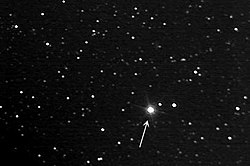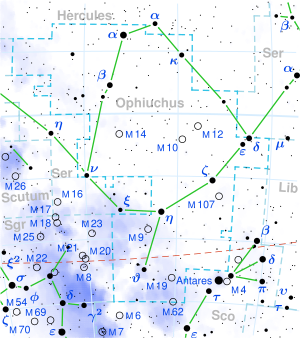Our website is made possible by displaying online advertisements to our visitors.
Please consider supporting us by disabling your ad blocker.
Barnard's Star
Barnard's Star is a small red dwarf star in the constellation of Ophiuchus. At a distance of 5.96 light-years (1.83 pc) from Earth, it is the fourth-nearest-known individual star to the Sun after the three components of the Alpha Centauri system, and is the closest star in the northern celestial hemisphere.[15] Its stellar mass is about 16% of the Sun's, and it has 19% of the Sun's diameter. Despite its proximity, the star has a dim apparent visual magnitude of +9.5 and is invisible to the unaided eye; it is much brighter in the infrared than in visible light.
The star is named after Edward Emerson Barnard,[16] an American astronomer who in 1916 measured its proper motion as 10.3 arcseconds per year relative to the Sun, the highest known for any star. The star had previously appeared on Harvard University photographic plates in 1888 and 1890.[17]
Barnard's Star is among the most studied red dwarfs because of its proximity and favorable location for observation near the celestial equator.[8] Historically, research on Barnard's Star has focused on measuring its stellar characteristics, its astrometry, and also refining the limits of possible extrasolar planets. Although Barnard's Star is ancient, it still experiences stellar flare events, one being observed in 1998.[18]
Barnard's Star hosts at least one planet, Barnard's Star b, a close-orbiting sub-Earth discovered in 2024, with additional candidates suspected. Previously, it was subject to multiple claims of planets that were disproven.[6]
- ^ a b c d e Cite error: The named reference
GaiaDR3was invoked but never defined (see the help page). - ^ a b c d e f g h i j Koen, C.; Kilkenny, D.; Van Wyk, F.; Marang, F. (2010). "UBV(RI)C JHK observations of Hipparcos-selected nearby stars". Monthly Notices of the Royal Astronomical Society. 403 (4): 1949. Bibcode:2010MNRAS.403.1949K. doi:10.1111/j.1365-2966.2009.16182.x.
- ^ Gizis, John E. (February 1997). "M-Subdwarfs: Spectroscopic Classification and the Metallicity Scale". The Astronomical Journal. 113 (2): 806–822. arXiv:astro-ph/9611222. Bibcode:1997AJ....113..806G. doi:10.1086/118302. S2CID 16863021.
- ^ a b c Cutri, R. M.; Skrutskie, M. F.; Van Dyk, S.; Beichman, C. A.; Carpenter, J. M.; Chester, T.; Cambresy, L.; Evans, T.; Fowler, J.; Gizis, J.; Howard, E.; Huchra, J.; Jarrett, T.; Kopan, E. L.; Kirkpatrick, J. D.; Light, R. M.; Marsh, K. A.; McCallon, H.; Schneider, S.; Stiening, R.; Sykes, M.; Weinberg, M.; Wheaton, W. A.; Wheelock, S.; Zacarias, N. (June 2003). "VizieR Online Data Catalog: 2MASS All-Sky Catalog of Point Sources (Cutri+ 2003)". VizieR On-line Data Catalog: II/246. 2246. Bibcode:2003yCat.2246....0C.
- ^ Samus, N. N.; Kazarovets, E. V.; Durlevich, O. V.; Kireeva, N. N.; Pastukhova, E. N. (2009) [First published 2009]. "VizieR Online Data Catalog: General Catalogue of Variable Stars (Samus+, 2007–2017)". VizieR On-line Data Catalog: B/gcvs. 1: B/gcvs. Bibcode:2009yCat....102025S.
- ^ a b c d e f Cite error: The named reference
GonzálezHernández2024was invoked but never defined (see the help page). - ^ a b Cite error: The named reference
Pineda2021was invoked but never defined (see the help page). - ^ a b Dawson, P. C.; De Robertis, M. M. (May 2004). "Barnard's Star and the M Dwarf Temperature Scale". The Astronomical Journal. 127 (5): 2909–2914. Bibcode:2004AJ....127.2909D. doi:10.1086/383289.
- ^ Cite error: The named reference
Riedel2005was invoked but never defined (see the help page). - ^ Cite error: The named reference
an230_77was invoked but never defined (see the help page). - ^ Lippincott, Sarah Lee (1960). "A Model of our Stellar Neighborhood". Astronomical Society of the Pacific Leaflets. 8 (377): 207. Bibcode:1960ASPL....8..207L.
- ^ Cite error: The named reference
bis11_12_170was invoked but never defined (see the help page). - ^ Seeliger, Hugo; Bauschinger, Julius (1890). "Erstes Müchner Sternverzeichniss enthaltend die mittleren Örter von 33082 Sternen". Neue Annalen der Koeniglichen Sternwarte in Bogenhausen bei Muenchen. 1: 1. Bibcode:1890AnBog...1....1S.
- ^ Cite error: The named reference
rukl1999was invoked but never defined (see the help page). - ^ "Astronomy Survey Fall 2010". Archived from the original on 26 June 2013. Retrieved 5 May 2013.
- ^ Cite error: The named reference
Kalerwas invoked but never defined (see the help page). - ^ Barnard, E. E. (September 1916). "A small star with large proper motion". The Astronomical Journal. 29 (695): 181–183. Bibcode:1916AJ.....29..181B. doi:10.1086/104156.
- ^ Cite error: The named reference
PaulsonFlarewas invoked but never defined (see the help page).
Previous Page Next Page




